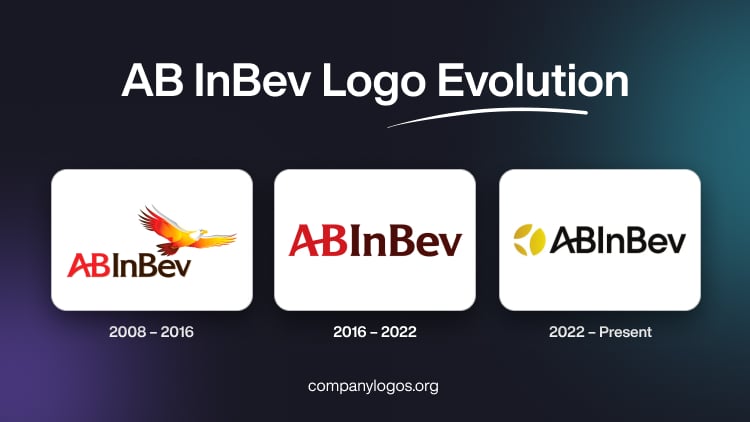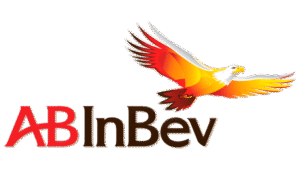
Anheuser-Busch InBev (AB InBev) is the world’s largest beer company, with a portfolio of over 500 beer brands. These include Budweiser, Stella Artois, and Corona. As a result of several mergers and acquisitions, the AB InBev corporate identity has undergone a few changes. The article delves into the various logo changes over the years.
The Genesis of the AB InBev Logo (2008 – 2016)
In 2008, InBev acquired Anheuser-Busch, the iconic American brewer known for Budweiser. This $52 billion merger created Anheuser-Busch InBev (AB InBev). The new AB InBev logo introduced in 2008 featured a vibrant and dynamic eagle in flight. It had a blend of red, orange, and yellow colour tones. The wordmark “AB InBev” was written in a refined custom serif font below.
The “AB” part of the brand name was displayed in red, while the rest was brown. There were no gaps between the two parts of the name, but the horizontal bar of the letter “A” arched into the letter “B”.
The eagle, borrowed conceptually from Anheuser-Busch’s heritage, symbolised freedom, global reach, and strength. Further, the gradient colours added energy and movement and reflected the dynamic nature of the newly formed global entity.

(2016 – 2022)
In 2016, SABMiller, the UK-based brewer, became a part of the AB InBev family. The new logo to introduce this change was designed by Ian Brignell for Jones Knowles Ritchie. The new design did not have the hovering eagle, which was mostly associated with the Anheuser-Busch company. However, the wordmark remained mostly unchanged, except the letters became bigger and the colours brighter.

(2022 – Present)
In 2022, AB InBev launched a refreshed visual identity as part of a broader shift toward sustainability, digital transformation, and innovation. It introduced the third player, SABMiller, into the logo in the form of the yellow ball to the left. The ball comprising three petals of different sizes symbolised the three players that formed AB InBev. The wordmark executed in a smooth sans-serif typeface appears in black.

The Elements of the AB InBev Logo
Font
The wordmark that forms part of the AB InBev logo is written using a sleek and bold serif typeface. Its smooth lines and serifs are similar to the Quadrat Serial typeface. Interestingly, the horizontal bar of the letter “A” forms an arc from the left bottom corner to the middle of the letter “B”. This conveys family continuity, as Anheuser’s daughter married Busch, and the company was passed down over generations.
Colour
The AB InBev logo employs a total of five colours – white, yellow, red, brown, and black. The colour white signifies an aspiration to start anew, yellow stands for the joy of life, and red signifies love, energy, resilience, and a desire for change. The colour brown is about experience and stability, while black projects the power and strength of the company.
The History of AB InBev
The journey of the company began in Belgium, where the Artois brewery (dating back to 1366) and the Piedboeuf brewery (founded in 1812) merged in 1987 to form Interbrew. Interbrew rapidly expanded by acquiring breweries in Belgium and internationally. These included Labatt in Canada (1995), Bass and Whitbread in the UK (2000), and Beck’s in Germany (2001). By the late 1990s and early 2000s, Interbrew had become a major multinational brewer.
In Brazil, AmBev was formed in 1999 through the merger of Brahma and Antarctica, which were two of South America’s leading breweries. AmBev quickly established dominance in Latin America and became a global player. In 2004, Interbrew and AmBev merged to create InBev and instantly became one of the world’s largest brewers by volume. InBev operated in over 30 countries and sold beer in more than 130 countries. It had a strong portfolio including Stella Artois, Beck’s, Brahma, and Leffe.
In 2008, InBev acquired Anheuser-Busch, the iconic American brewer known for Budweiser, Michelob, and Busch, in a $52 billion deal. This merger created Anheuser-Busch InBev (AB InBev). The company has its headquarters in Leuven, Belgium, and major offices in New York, São Paulo, London, St Louis, and other cities. In 1852, Anheuser-Busch was founded in St. Louis, Missouri, and it became the largest brewing company in the United States. Its flagship brand, Budweiser, became synonymous with American beer culture.
In 2016, AB InBev acquired SABMiller for $107 billion and further consolidated its position as the world’s largest brewer. SABMiller was the second-largest beer company globally at the time. To meet the regulatory requirements, AB InBev divested certain brands and assets, which included selling the Miller portfolio outside the U.S. to Molson Coors.
Today, AB InBev controls more than 500 beer brands that are sold in over 150 countries. These include global names like Budweiser, Stella Artois, Beck’s, Brahma, Corona, Leffe, and Hoegaarden. The company employs nearly 144,000 people and reported revenues of nearly $60 billion in 2024. Also, AB InBev is publicly listed on Euronext Brussels, with secondary listings in Mexico, South Africa, and the U.S.
Interesting Facts About AB InBev
- AB InBev is the largest beer brewer globally. It lords over a quarter of the world’s beer market bye – 27.4% as of 2023.
- The company operates in more than 50 countries, employs around 169,000 people, and sells over 500 beer brands in more than 150 markets worldwide.
- AB InBev’s brewing heritage dates back over 800 years. It boasts origins in Belgian abbeys and the founding of Den Hoorn Brewery in Leuven in the 14th century.
- The company’s portfolio includes some of the most recognised beer brands globally. These include Budweiser, Bud Light, Corona, Stella Artois, Beck’s, Leffe, Hoegaarden, and Brahma.
- AB InBev was formed through a series of high-profile mergers:
- In 2004, Interbrew (Belgium) and AmBev (Brazil) merged to create InBev.
- In 2008, InBev acquired Anheuser-Busch (USA), forming AB InBev.
- In 2016, AB InBev acquired SABMiller for $107 billion, which was the largest beer industry deal ever.
- In 2023, AB InBev sold 518 million hectolitres of beer, which was enough to fill over 200,000 Olympic-sized swimming pools.
- The company reported revenues of $59.4 billion in 2023 and a net profit (EBITDA) of $20 billion. This made it one of the world’s top five consumer product companies by EBITDA.
- AB InBev works directly with nearly 24,000 farmers, more than 75% of whom are smallholders. It does so to source ingredients sustainably and support local economies.
- The yeast used to brew Budweiser today descends directly from the original culture used by founder Adolphus Busch in the 19th century.
- The AB InBev Foundation focuses on reducing the harmful consumption of alcohol and advancing the United Nations Sustainable Development Goals.
- In 2023, AB InBev spent $7.2 billion on marketing, which reflected its commitment to maintaining brand dominance worldwide.
- The acquisition of SABMiller in 2016 made AB InBev the world’s largest brewer. However, it also forced the sale of several brands to satisfy global antitrust regulators, including the sale of MillerCoors to Molson Coors.
- AB InBev holds about 34% of the U.S. beer market, which makes it the dominant player in America as well as globally.
Finally
The AB InBev logo and its variants show the remarkable journey of the company from regional brewers to a global beverage titan. The expansive span of the logo, be it the rich symbolism of the soaring eagle or the sleek, modern design of today, reflects AB InBev’s strategic priorities and market positioning.